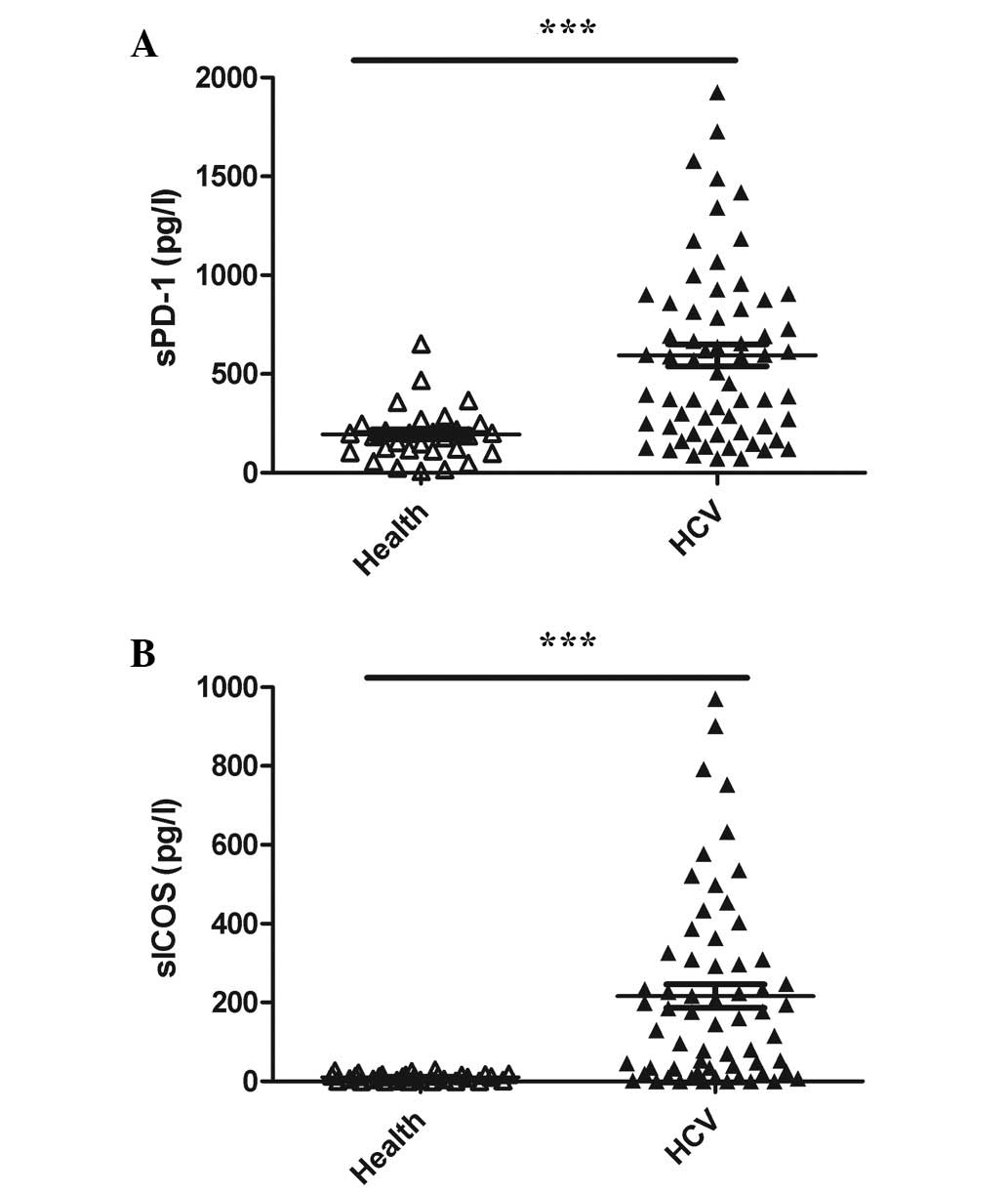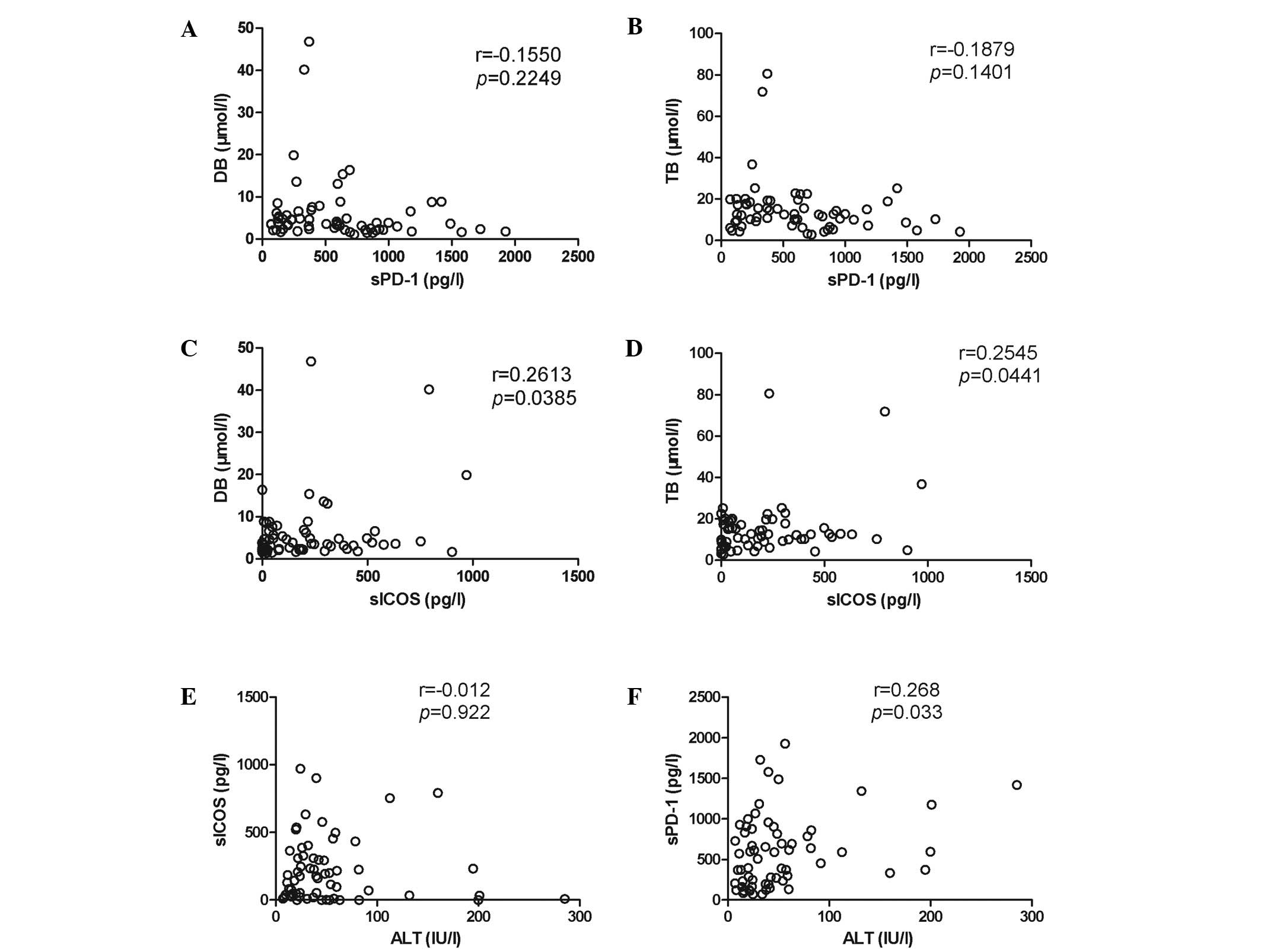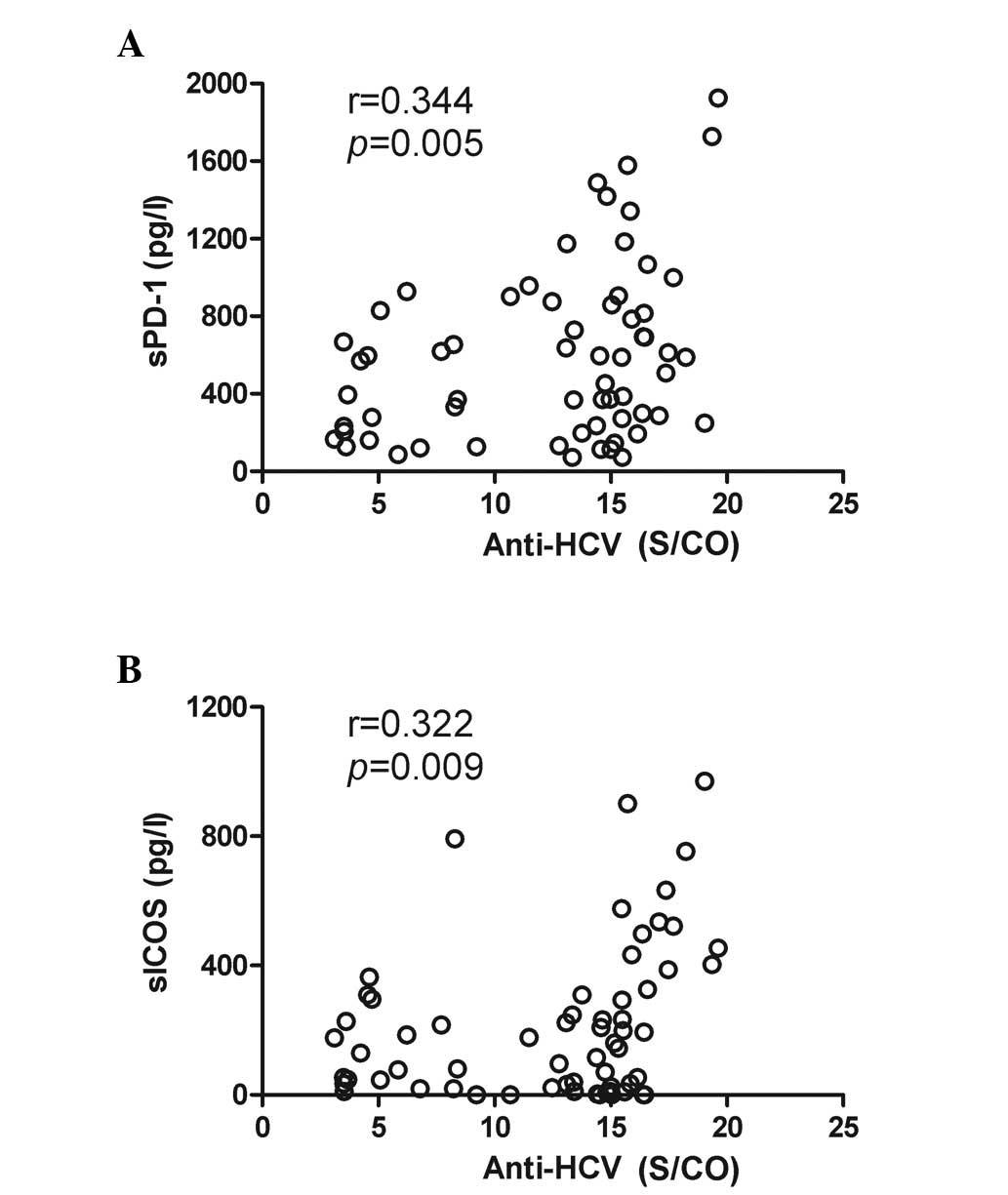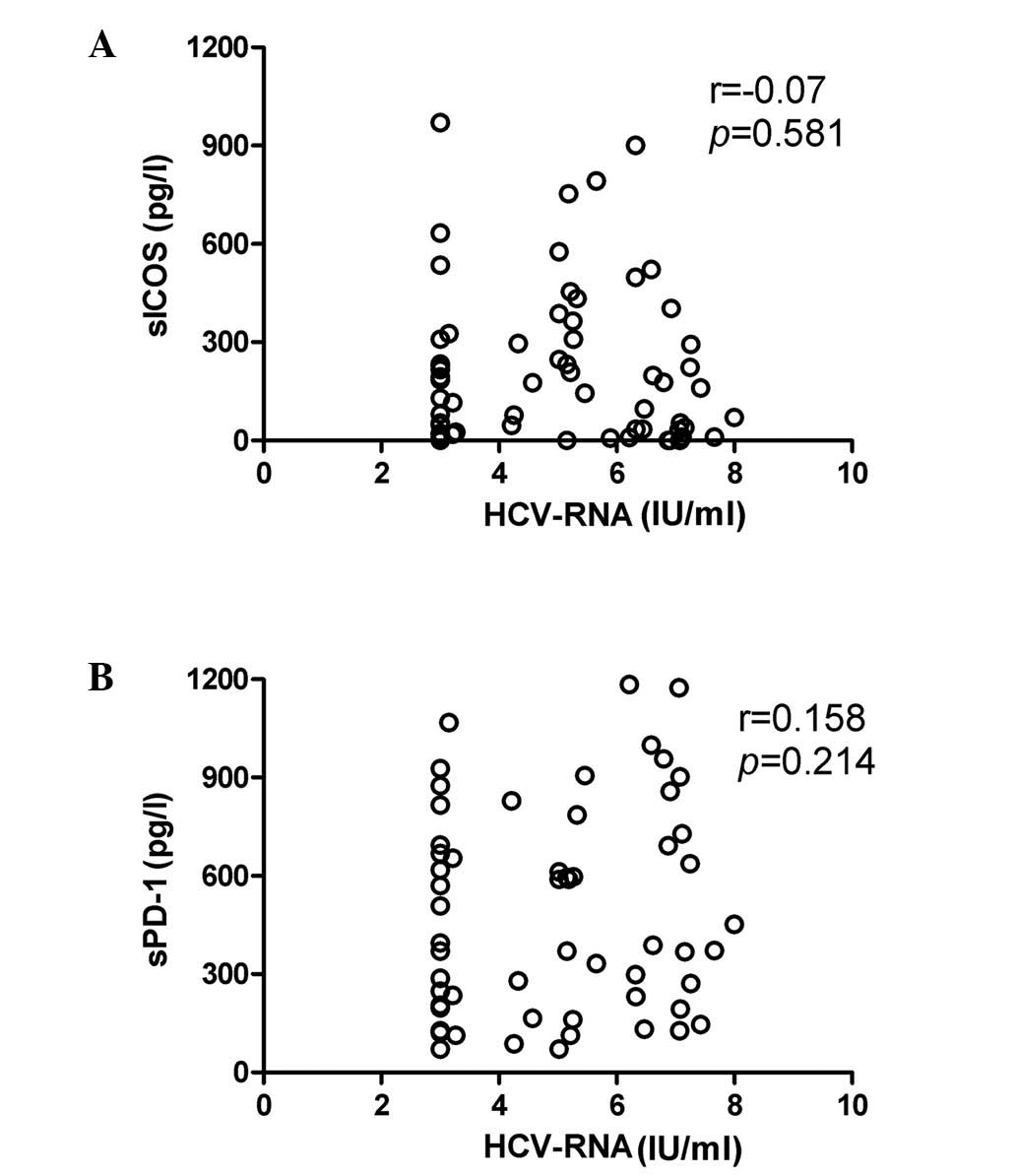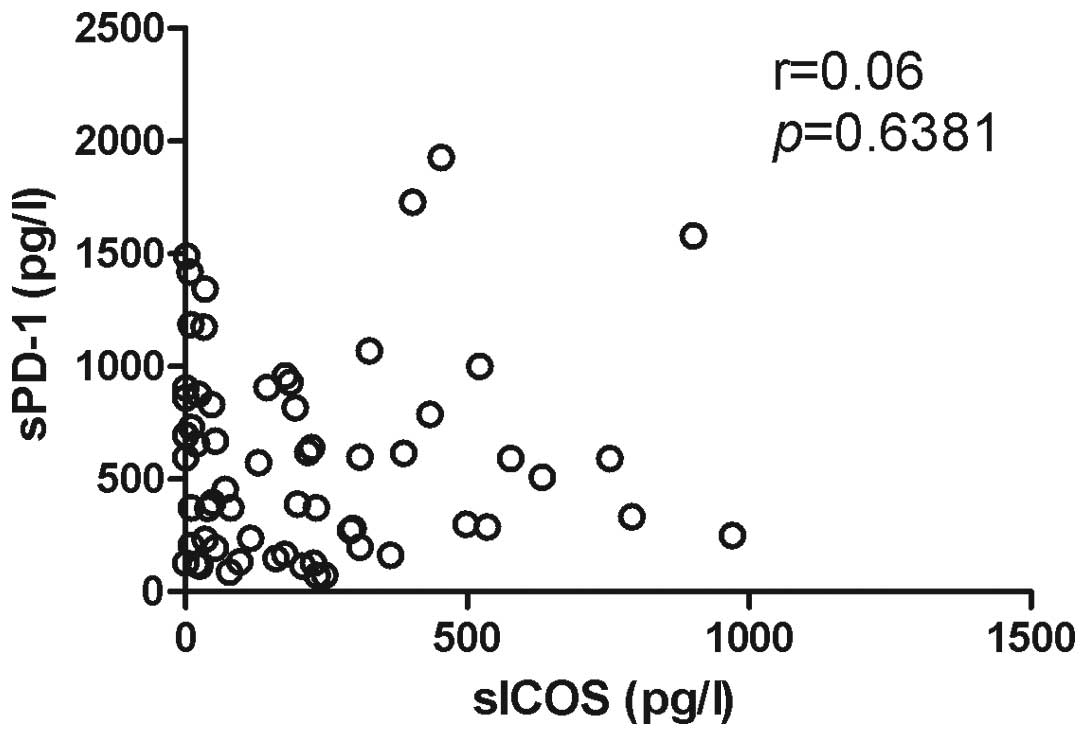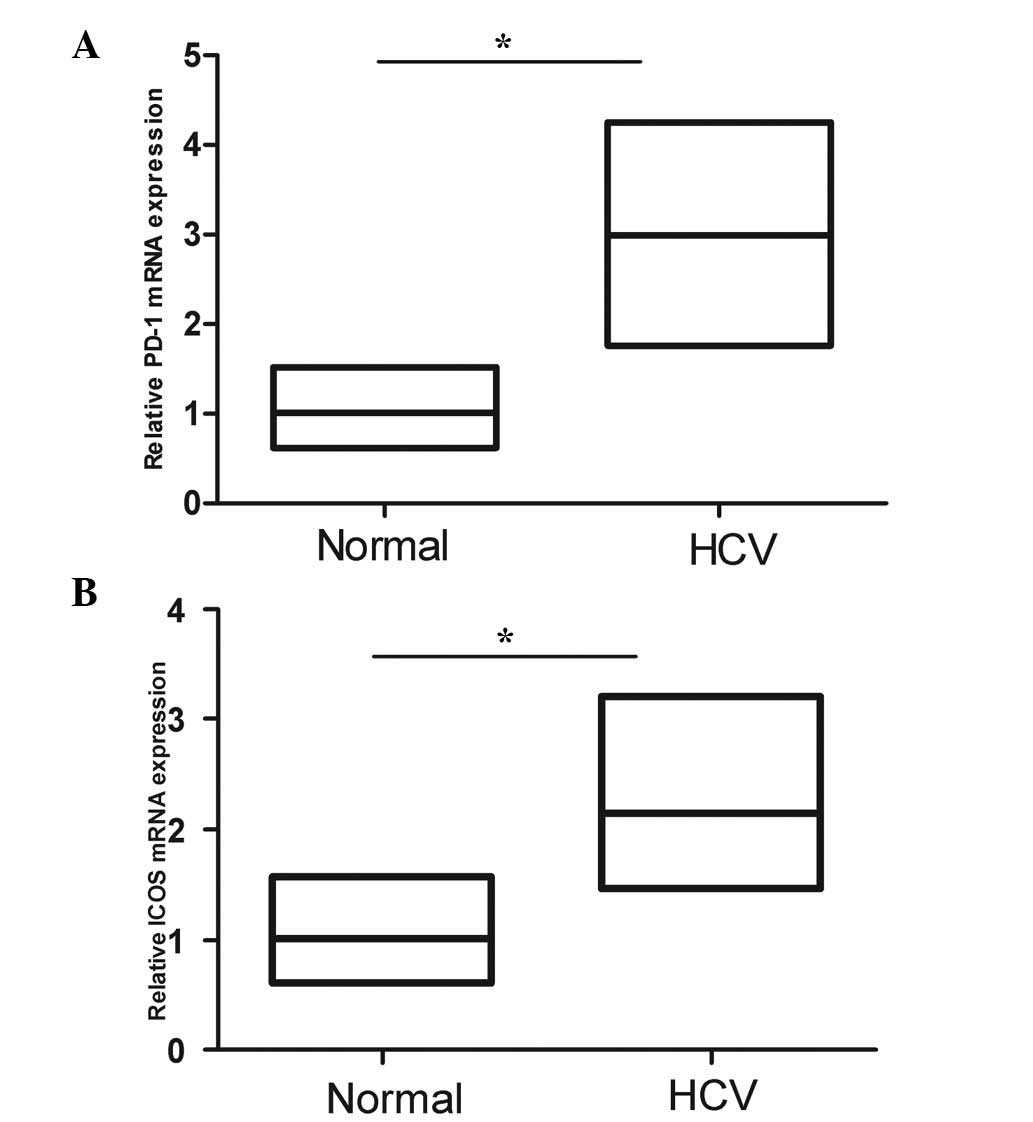Aberrant production of soluble inducible T‑cell co‑stimulator (sICOS) and soluble programmed cell death protein 1 (sPD‑1) in patients with chronic hepatitis C
- Authors:
- Published online on: February 19, 2013 https://doi.org/10.3892/mmr.2013.1326
- Pages: 1197-1202
Abstract
Introduction
Almost 3% of the world’s population is infected with hepatitis C virus (HCV) (1). Chronic infection with HCV may result in both hepatic and extrahepatic disease, such as inflammation of the liver, which in turn may progress to cirrhosis, liver failure or cancer (2). The mechanism whereby HCV damages the liver is unclear, but there is much evidence to suggest that the immunity disorder is one of the important reasons for this (3). Active T cells in the liver may target those hepatocytes infected with HCV and clear them to prevent virus prevalence. Once infected with HCV, the HCV particles are processed by antigen-presenting cells (APC) and then presented to naive T cells by major histocompatibility complex (MHC) molecules, which deliver a primary signal to initiate T-cell activation by the engagement of the T-cell receptor/CD3 complex with foreign antigens associated with MHC. In addition, the optimal activation of T cells requires a co-stimulatory signal. Co-stimulatory signals include CD28/B7 and TNFR/TNF superfamilies; however, numerous novel molecules, such as programmed death 1 (PD-1), inducible T-cell co-stimulator (ICOS), B and T lymphocyte attenuator (BTLA), B7-H1 (PD-L1), B7RP-1 (B7H,B7-H2), B7-DC (PD-L2), B7-H3 and B7-H4, have recently been identified (4). These signals are also important in physiological functions and pathologic progress (4). Cytotoxic T lymphocytes (CTL) are hypothesized to control HCV replication, but these fail in numerous persistently infected individuals (5–7). Additionally, the CTL numbers are often low in chronic HCV patients, as the HCV core protein is able to suppress the host immune response (8–11). Monocyte-derived dendritic cells (Mo-DCs) generated from hepatitis C patients have an impaired ability to stimulate allogeneic CD4+ T cells that are not able to release a significant amount of effective cytokines (12). However, the exact immunopathological mechanisms by which HCV escapes the host immune response remain unknown.
Previous studies have demonstrated that co-stimulators, PD-1 and ICOS, are involved in the HCV pathogenic progress. PD-1 receptor expression is greater in dysfunctional HCV-specific T cells compared with normal cells (13,14). In acute HCV affections, PD-1 also upregulates CD4+ and CD8+ T lymphocytes. Interaction with its ligand, PD-L1, in the HCV-specific T cells inhibits effector functions and induces T-cell apoptosis. In an HCV core(+) mouse model, CD8+ cells were accompanied with enhanced PD-1 expression. The core antigen of HCV is an immunomodulatory protein that alters the adaptive immune response (11). The aforementioned findings demonstrate that PD-1 is randomly expressed in HCV-specific immune cells, although its function has not yet been fully elucidated.
Another co-stimulator, ICOS, also assists in activating adaptive immunity, particularly by aiding antibody secretion by B cells. However, there is limited number of studies concerning ICOS in HCV patients. Ribavirin downmodulates ICOS in CD4+ T cells and assists HCV clearance, indicating that ICOS prevention is a novel choice for HCV treatment (15). In addition, ICOS has been found to be upregulated in chronic HBV-infected cells.
Previous studies have demonstrated that there are different isoforms of PD-1 and ICOS from alternatively spliced messenger RNA (mRNA), and the soluble isoforms of these may regulate immune homeostasis (16). In addition, soluble ICOS (sICOS) and soluble PD-1 (sPD-1) have been identified to be present in numerous diseases, particularly autoimmune diseases, such as systemic lupus erythematosus (SLE) and cancer. However, the clinical significance of these markers in chronic HCV infection remains uncertain. The aim of this study was to elucidate the correlation between these soluble molecules and T-cell activation in chronic HCV patients, and to investigate their possible association with the pathogenesis of HCV.
Materials and methods
Subjects
Sixty-three Chinese patients with chronic HCV and 30 volunteers (normal controls) were recruited in this study. The individuals with chronic HCV were patients at The Affiliated Hospital of North Sichuan Medical College and the Yongchuan Hospital of Chongqing Medical University. All patients were anti-HCV antibody- and HCV RNA-positive, but negative for HBV, HDV and human immunodeficiency virus, and without any other disease-related liver damage. Patients with concomitant illness and autoimmune disease were excluded. No patients had accepted administration of anti-HCV agents or steroids one year prior to sampling. Each individual signed the written informed consent, and the protocol was approved by the Clinical Research Ethics Committee of the affiliated hospital of North Sichuan Medical College.
Virological detection and biochemistry assays
Anti-HCV antibody was determined by a kit (i2000; Abbort, Wiesbaden, Germany). The HCV RNA level was determined by real-time RT-PCR using the LightCycler® 480 System (Roche Diagnostics GmbH, Mannheim, Germany) with a detection sensitivity of 1×103 IU/ml. Serum alanine aminotransferase (ALT), aspartate aminotransferase (AST), total bilirubin (TB) and direct bilirubin (DB) were measured by the Synchron LX20 auto-analyzer (Beckman Coulter Inc., Fullerton, CA, USA).
ELISA assay of sICOS and sPD-1
Serum concentrations of sICOS and sPD-1 of all patients and the normal control group were detected with ELISA (R&D Systems, Inc., Minneapolis, MN, USA). The assay was conducted according to the manufacturer’s instructions.
Real-time RT-PCR
Peripheral blood mononuclear cells (PBMC) were obtained according to the specification of the kit (Tianjin Hao Yang Biological Manufacture Co., Ltd., Tianjin, China). RNA extraction and cDNA synthesis were performed according to the experimental guidelines of Promega Corporation (Madison, WI, USA). The PCR primer sequences used were: Sense 5′-GTTCCCTGAGTTGTTTG-3′ and antisense: 5′-TCATCTTGAGGTGTCCC-3′ for ICOS; sense 5′-CCGCCTTCTGTAATGGTTTGA-3′ and antisense: 5′-GGGCAGCTGTATGATCTGGAA-3′ for PD-1 (17). GAPDH was used as an internal control. Relative quantification was calculated using the 2−ΔΔCt formula.
Statistical analysis
The Mann-Whitney rank sum test was used to analyze the difference in sPD-1 and sICOS levels between normal controls and patients. The Spearman’s rank correlation test was used to assess the correlation between sPD-1, sICOS and ALT or anti-HCV antibody levels. Results are expressed as the median (interquartile range). The data were analyzed with OriginPro 8.5 statistical software. P<0.05 was considered to indicate a statistically significant difference.
Results
Numerous biochemical marker levels were increased in chronic HCV patients compared with the normal controls
Sixty-three patients with chronic HCV infection and 30 normal controls were studied. The detection results of ALT, AST, DB and TB are summarized in Table I. Serum AST, ALT, TB and DB were significantly elevated in the HCV group compared with the normal control group, indicating that HCV chronic infection causes liver damage.
Table IComparison of multiple biochemical and immunological markers between normal controls and chronic HCV patients. |
Serum levels of sPD-1 and sICOS were elevated in chronic HCV patients compared with the normal controls
The sPD-1 and sICOS serum levels were extremely low in the normal controls, a large number of which were below the detection limit of the two kits (Fig. 1A and B, respectively). However, the sPD-1 and sICOS levels were significantly higher in patients with chronic HCV infection compared with the normal controls (P<0.01 for both; Fig. 1A and B, respectively).
sPD-1 and sICOS are correlated with anti-HCV antibody levels in chronic HCV patients
A potential correlation was identified between serum ALT and sPD-1/sICOS. A significant correlation between ALT and sPD-1 levels was observed (r=0.268, P=0.033; Fig. 2F), although sICOS levels did not correlate with ALT levels (Fig. 2E). sPD-1 levels did not correlate with the DB and TB levels (Fig. 2A and B, respectively), whereas the sICOS levels correlated with DB and TB levels (Fig. 2C and D, respectively), this correlation may have been due to the detection bias. However, the upregulation of DB may have been as a result of other factors. sPD-1 and sICOS serum levels correlated with anti-HCV antibody levels (sPD-1, r=0.344, P=0.005; sICOS, r=0.322, P=0.009; Fig. 3A and B, respectively), indicating that their infection may be an immune reaction in chronic HCV patients. However, no difference in sICOS or sPD-1 levels between HCV patients with normal and abnormal ALT results was detected (F sig. 4A and B, respectively).
No correlation was evident between HCV RNA levels and sPD-1/sICOS concentration
HCV RNA levels were measured using real-time RT-PCR and the statistical analysis revealed that there was no significant correlation between HCV RNA levels and sICOS (P>0.05) or sPD-1 (P>0.05) levels in patients with chronic HCV infection (Fig. 4A and B, respectively). In addition, the correlation between sPD-1 and sICOS levels was not significant (Fig. 5).
PD-1 and ICOS mRNA levels were elevated in PBMC of HCV patients
Quantitative RT-PCR demonstrated that the mRNA levels of PD-1 and ICOS in PBMC were elevated in chronic HCV patients compared with the normal controls (Fig. 6A and B, respectively). Considering that sPD-1 and sICOS may be shed from the membrane of these cells, the upregulation of these molecules may be one of the reasons to explain the high levels of PD-1 and ICOS in HCV patients.
Discussion
Communication between T cells and APC initiates the immune response to HCV infection. Dysfunction of T cells and abnormal immunomodulation molecules of APC in HCV patients have been demonstrated (18,19). However, the soluble co-stimulatory molecules in chronic HCV patients has not previously been investigated.
In the present study, we demonstrated that the serum concentrations of sPD-1 and sICOS were markedly elevated in chronic HCV patients compared with the normal controls. The levels of sPD-1 and sICOS were significantly correlated with the anti-HCV antibody serum levels in HCV patients. The anti-HCV antibody levels are recognized as HCV infection markers, and high anti-HCV antibody levels indicate active replication of HCV. However, in the present study, the sPD-1 and sICOS levels were not significantly correlated with the HCV RNA level. This may be due to the fact that the immune regulation ability of PD-1 and ICOS is not very effective at influencing the virus replication; thus, they are not sensitively reactive to the changes in HCV RNA levels. There are numerous co-stimulatory molecules, such as CD28, CD80, CD86 and CTLA, all of which have two forms (the membrane and soluble forms) (20). sPD-1 and sICOS are formed from alternative mRNA splicing. Since sPD-1, and not sICOS, has been demonstrated to be highly expressed in the active lymphocytes of autoimmune diseases (21), sPD-1 may not be a specific molecule in chronic HCV infection. Additionally, sICOS has not been investigated previously. Therefore, these two markers are not necessarily disease-specific molecules. However, due to their correlation with the anti-HCV antibody, sPD-1 and sICOS may be partially associated with virus replication and HCV pathogenesis, which may lead to the dysregulation of T-cell co-stimulation.
In the present study, we found that the sPD-1 and sICOS levels were significantly higher in the HCV group compared with the normal control group. However, the biological significance of these results remains unknown. Both of these molecules have an immunomodulatory function. Increased production of sPD-1 and sICOS may interfere with the patient’s adaptive immune function. sPD-1 and sICOS may compete and interfere with the PD-1 and ICOS interactions with their respective ligands, leading to immune dysregulation and a defective immune response. PD-1/PD-L has been demonstrated to negatively regulate the T-cell response, both in the primary and secondary immune responses (22). Blocking the PD-1/PD-L pathway could enhance the anti-virus immunity. Thus, the abnormal expression of sPD-1 may interact with PD-L and inhibit PD-1/PD-L axis-induced T-cell apoptosis, leading to continuation of T-cell activation and causing inflammation. ICOS is usually expressed in activated T cells and amplifies the first stimulator signal. Abnormal sICOS is likely to compete with ICOS-L and reduce T-cell reaction, which may cause T-cell exhausion. Both PD-1 and ICOS activation have been demonstrated to induce Th2 cytokine release and in turn suppress Th1 inflammation, leading to liver damage (23). Humoral immune function may also be enhanced by ICOS. ICOS knockout may prevent T cell-specific germinal center formation, as B cells have been observed to be inactive and incapable of migrating to form the germinal center. The T cells specifically induced immunoglobulin dyspoiesis, indicating that high antibody production is ICOS-dependent (24). In the present study, the high levels of sICOS were concordant with the high levels of anti-HCV antibody, which is explained by the fact that sICOS is predominantly shed from the active T-cell membranes. Thus, the aberrant production of sPD-1 and sICOS may be important in HCV infection. The detailed immunopathological roles of those soluble co-stimulatory molecules in HCV infection require further study.
PD-1 expression levels in HCV-specific CD8+ and CD4+ T cells do not correlate with clinical outcomes (13). In addition, sPD-1 is upregulated in certain autoimmune diseases. Notably, HCV has recently been classified as an autoimmune disease. In the present study, TB and DB were weakly correlated with sPD-1, but not with sICOS. Similarly, ALT was correlated with sPD-1 and not with sICOS. We suggest that sPD-1 and sICOS are not disease-specific indicators, due to their weak immunomodulatory ability and the fact that their levels do not change synchronously with other biochemical markers. sPD-1 and sICOS are usually aberrant in immune disorder disease; however, they may have little correlation with the changes in liver function (Fig. 4).
To elucidate the mechanism of soluble sPD-1 and sICOS generation, we detected the transcription level changes of the two molecules. As expected, PD-1 and ICOS levels are both higher in the HCV patient group compared with the normal control group. As the sPD-1 and sICOS mRNA levels corresponded with their membrane protein forms, the high ICOS and PD-1 mRNA levels may indicate that their soluble forms predominantly shed from the membrane, and may have a negative regulation of their function. Although the exact mechanism of the soluble forms in immune regulation is not yet clear, the different concentrations of soluble forms may have different functions in HCV-infected patients. Blocking PD-1/PD-L has been demonstrated to be a useful way of recovering T-cell function. T cells proliferate significantly following blocking of PD-1 (25). However, in our study, upregulation of sPD-1 did not induce T-cell proliferation and clearing of the virus. Thus, T-cell function and subtype in the HCV patients should be identified, and the different concentrations and functions of sPD-1 in the T cells from HCV patients should be investigated. No studies are available regarding the manner in which sICOS affects T-cell immunity and whether it functions as a competitor of ICOS, both of which require further study.
In summary, this is the first study to identify soluble co-stimulatory molecules in chronic HCV patients. Our results provide a new direction and experimental basis to elucidate the pathological mechanism of chronic HCV infection. The soluble co-stimulatory molecules may be a new therapeutic target in HCV therapy. The biological function of sPD-1 and sICOS in HCV infection requires further study in order for their therapeutic function to be investigated.
References
|
Sorrell MF, Belongia EA, Costa J, Gareen IF, Grem JL, Inadomi JM, Kern ER, McHugh JA, Petersen GM, Rein MF, et al: National Institutes of Health consensus development conference statement: management of hepatitis B. Hepatology. 49:S4–S12. 2009. View Article : Google Scholar : PubMed/NCBI | |
|
Rodriguez-Luna H and Vargas HE: Management of hepatitis C virus infection in the setting of liver transplantation. Liver Transpl. 11:479–489. 2005. View Article : Google Scholar : PubMed/NCBI | |
|
Mengshol JA, Golden-Mason L and Rosen HR: Mechanisms of Disease: HCV-induced liver injury. Nat Clin Pract Gastroenterol Hepatol. 4:622–634. 2007. View Article : Google Scholar : PubMed/NCBI | |
|
Sharpe AH and Freeman GJ: The B7-CD28 superfamily. Nat Rev Immunol. 2:116–126. 2002. View Article : Google Scholar | |
|
Cooper S, Erickson AL, Adams EJ, Kansopon J, Weiner AJ, Chien DY, Houghton M, Parham P and Walker CM: Analysis of a successful immune response against hepatitis C virus. Immunity. 10:439–449. 1999. View Article : Google Scholar : PubMed/NCBI | |
|
Thimme R, Oldach D, Chang KM, Steiger C, Ray SC and Chisari FV: Determinants of viral clearance and persistence during acute hepatitis C virus infection. J Exp Med. 194:1395–1406. 2001. View Article : Google Scholar : PubMed/NCBI | |
|
Puig M, Mihalik K, Tilton JC, Williams O, Merchlinsky M, Connors M, Feinstone SM and Major ME: CD4+ immune escape and subsequent T-cell failure following chimpanzee immunization against hepatitis C virus. Hepatology. 44:736–745. 2006. | |
|
Rehermann B, Chang KM, McHutchinson J, Kokka R, Houghton M, Rice CM and Chisari FV: Differential cytotoxic T-lymphocyte responsiveness to the hepatitis B and C viruses in chronically infected patients. J Virol. 70:7092–7102. 1996.PubMed/NCBI | |
|
Nelson DR, Marousis CG, Davis GL, Rice CM, Wong J, Houghton M and Lau JY: The role of hepatitis C virus-specific cytotoxic T lymphocytes in chronic hepatitis C. J Immunol. 158:1473–1481. 1997.PubMed/NCBI | |
|
Cabrera R, Tu Z, Xu Y, Firpi RJ, Rosen HR, Liu C and Nelson DR: An immunomodulatory role for CD4(+)CD25(+) regulatory T lymphocytes in hepatitis C virus infection. Hepatology. 40:1062–1071. 2004. | |
|
Yao ZQ, King E, Prayther D, Yin D and Moorman J: T cell dysfunction by hepatitis C virus core protein involves PD-1/PDL-1 signaling. Viral Immunol. 20:276–287. 2007. View Article : Google Scholar : PubMed/NCBI | |
|
Li S, Roberts S, Plebanski M, Gouillou M, Spelman T, Latour P, Jackson D, Brown L, Sparrow RL, Prince HM, et al: Induction of multi-functional T cells in a phase I clinical trial of dendritic cell immunotherapy in hepatitis C virus infected individuals. PLoS One. 7:e393682012. View Article : Google Scholar : PubMed/NCBI | |
|
Kasprowicz V, Schulze Zur Wiesch J, Kuntzen T, Nolan BE, Longworth S, Berical A, Blum J, McMahon C, Reyor LL, Elias N, et al: High level of PD-1 expression on hepatitis C virus (HCV)-specific CD8+ and CD4+ T cells during acute HCV infection, irrespective of clinical outcome. J Virol. 82:3154–3160. 2008. View Article : Google Scholar : PubMed/NCBI | |
|
Rutebemberwa A, Ray SC, Astemborski J, Levine J, Liu L, Dowd KA, Clute S, Wang C, Korman A, Sette A, et al: High-programmed death-1 levels on hepatitis C virus-specific T cells during acute infection are associated with viral persistence and require preservation of cognate antigen during chronic infection. J Immunol. 181:8215–8225. 2008. View Article : Google Scholar | |
|
Atsukawa M, Nakatsuka K, Kobayashi T, Shimizu M, Tamura H, Harimoto H, Takahashi H and Sakamoto C: Ribavirin downmodulates inducible costimulator on CD4+ T cells and their interleukin-10 secretion to assist in hepatitis C virus clearance. J Gastroenterol Hepatol. 27:823–831. 2012.PubMed/NCBI | |
|
Nielsen C, Ohm-Laursen L, Barington T, Husby S and Lillevang ST: Alternative splice variants of the human PD-1 gene. Cell Immunol. 235:109–116. 2005. View Article : Google Scholar : PubMed/NCBI | |
|
Meng Q, Yang P, Li B, Zhou H, Huang X, Zhu L, Ren Y and Kijlstra A: CD4+PD-1+ T cells acting as regulatory cells during the induction of anterior chamber-associated immune deviation. Invest Ophthalmol Vis Sci. 47:4444–4452. 2006.PubMed/NCBI | |
|
Klenerman P and Semmo N: Cellular immune responses against persistent hepatitis C virus: gone but not forgotten. Gut. 55:914–916. 2006. View Article : Google Scholar : PubMed/NCBI | |
|
Koziel MJ: Cellular immune responses against hepatitis C virus. Clin Infect Dis. 41(Suppl 1): S25–S31. 2005. View Article : Google Scholar : PubMed/NCBI | |
|
Magistrelli G, Jeannin P, Elson G, Gauchat JF, Nguyen TN, Bonnefoy JY and Delneste Y: Identification of three alternatively spliced variants of human CD28 mRNA. Biochem Biophys Res Commun. 259:34–37. 1999. View Article : Google Scholar : PubMed/NCBI | |
|
Nishimura H, Nose M, Hiai H, Minato N and Honjo T: Development of lupus-like autoimmune diseases by disruption of the PD-1 gene encoding an ITIM motif-carrying immunoreceptor. Immunity. 11:141–151. 1999. View Article : Google Scholar : PubMed/NCBI | |
|
Greenwald RJ, Freeman GJ and Sharpe AH: The B7 family revisited. Annu Rev Immunol. 23:515–548. 2005. View Article : Google Scholar : PubMed/NCBI | |
|
Witsch EJ, Peiser M, Hutloff A, Buchner K, Dorner BG, Jonuleit H, Mages HW and Kroczek RA: ICOS and CD28 reversely regulate IL-10 on re-activation of human effector T cells with mature dendritic cells. Eur J Immunol. 32:2680–2686. 2002. View Article : Google Scholar : PubMed/NCBI | |
|
Warnatz K, Bossaller L, Salzer U, Skrabl-Baumgartner A, Schwinger W, van der Burg M, van Dongen JJ, Orlowska-Volk M, Knoth R, Durandy A, et al: Human ICOS deficiency abrogates the germinal center reaction and provides a monogenic model for common variable immunodeficiency. Blood. 107:3045–3052. 2006. View Article : Google Scholar : PubMed/NCBI | |
|
Nakamoto N, Cho H, Shaked A, Olthoff K, Valiga ME, Kaminski M, Gostick E, Price DA, Freeman GJ, Wherry EJ and Chang KM: Synergistic reversal of intrahepatic HCV-specific CD8 T cell exhaustion by combined PD-1/CTLA-4 blockade. PLoS Pathog. 5:e10003132009. View Article : Google Scholar : PubMed/NCBI |



